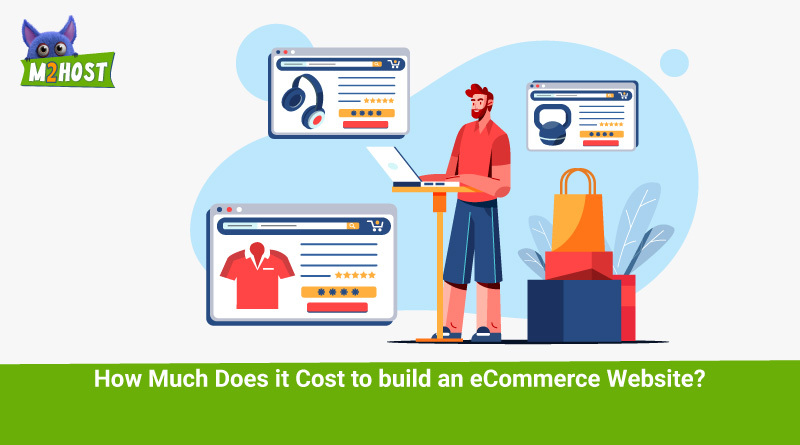Creating an online business is advantageous if you are managing a company that sells goods or services. However, it necessitates careful planning and attention to numerous details and intricacies that affect the cost of website development. Best ecommerce website development may be considered a one-time price, the costs associated with management and upkeep are ongoing. A number of elements will impact the development cost of your website. Although it can be difficult to determine the precise cost of developing an eCommerce website, several things can help, as we mentioned in this article.

It can be difficult to determine the cost of developing a website because of several variables, such as the platform being used, the complexity of the site, the design requirements, and any extra features that may be needed. The initial cost of website development are only one component of the picture; you also need to figure in continuing expenses for things like marketing, maintenance, updates, and scaling up your firm as it expands.
Why Should You Choose Website Development Packages?
There might be more affordable choices than creating a website yourself. In the long run, it can be more advantageous for you to work with a seasoned organization to assist with your website development needs. A seasoned web development firm or agency will have the know-how to assist you in choosing the best type of website for your organization. In addition, professionals will know exactly where to save costs in accordance with your specific needs. Making better decisions will be aided by the following factors:
- You’ll receive regular upkeep and support to guarantee your website functions flawlessly at all times.
- In the long run, it will save you money, time, and effort and reduce the cost of developing a website.
- If specialists take over, the job will be completed much more efficiently and effectively overall.
- It will spare you from learning fatigue by removing the need for you to spend time understanding every possible choice for each small technical detail of constructing the website.
What Is the Price of Developing an E-Commerce Website?
A wide range of elements might affect the ultimate cost when it comes to pricing for best eCommerce websites. Because of this, there is no one-size-fits-all response to the question, How much cost is needed to develop a website? Rather, depending on your company’s unique requirements and goals, the expenses may differ significantly.
Initially, the platform you choose to create an eCommerce website can have a big impact on the final cost. Open-source platforms offer more flexibility but require more setup and customization, and they often charge a monthly price that includes hosting and a suite of other capabilities. However, completely custom-built websites offer the experience maximum level at a higher cost.
Then, the size and complexity of your website are major factors in pricing. Your expenses will go up if you intend to offer a large selection of products, intricate shipping regulations, advanced search filters, or multilingual functionality.
Additionally, expenses may be impacted by the price of the website’s. Choosing a custom design made by skilled designers will always be more expensive than using an already-made template. However, this expenditure has the potential to greatly improve both user experience and, eventually, conversion rates.
Ultimately, the price will vary depending on what other features you need. These may consist of components such as social networking plugins, email marketing tools, CRM combinations, or sophisticated SEO functionality. While each of these components raises the overall cost, they can all improve your website’s functionality.
Design’s Effect on the Price of eCommerce Website development-
When it comes to eCommerce website development, design is much more than looks; it has a big impact on user experience, brand perception, and conversion rates. As such, it’s a crucial element that could affect the price of your eCommerce website. Let’s examine how your design decisions may impact your whole budget:
- Designing User Experience (UX)
Websites requires good UX design or a good understanding of how users interact with your website. A few simple features that can have a big impact on your conversion rate are obvious calls to action, quick page loads, and simple checkout procedures. Paying particular attention to UX design might affect your overall design expenses, whether you use templates or custom labor.
- Custom Design vs. Template
In most cases, using a already made template is the most affordable design approach. Numerous e-commerce systems provide a selection of premium and free templates that you can partially change. A customized design, however, can be the best option if you need certain design components or want a distinctive appearance. Hiring a professional web designer or design agency for custom designs might greatly increase your expenses.
- Branding
A unified, polished brand identity for your eCommerce website can increase the credibility and recall value of your company. Complementary color schemes, a unique logo, and unified typography are the elements that raise the cost and complexity of design.
- Design That is effective
Making sure your website is responsive—that is, that it appears and functions effectively on all device types—is now a must in an increasingly mobile environment. Even though a lot of contemporary themes are already responsive, a custom responsive design can increase expenses and complexity.
- Photographing Products
The websites requires high-quality images, and hiring a professional photographer can add significantly to the cost. As an alternative, depending on your items and budget, you can use stock photos or capture your own.
- Animations and Graphics
Adding unique visuals, interactive components, and animations to your website help raise the cost because they need more design work. Keep in mind that although high-quality design requires expense, it’s also an effective way to increase conversions and leave a lasting impact on your visitors. A good eCommerce website must strike a balance between your budget and design requirements.
Integrations Effect on the Cost of best eCommerce Websites-
Your website can be enhanced with additional functionality through integrations, which also streamline business operations and improve customer experience. But they also add to the total cost of an eCommerce website. Let’s examine some typical integrations and how your price is impacted by them:
- Tools for Search Engine Optimization (SEO) and Marketing
You may want to combine marketing and SEO solutions to advertise your eCommerce store and make it search engine friendly. Software for email marketing, social media scheduling, and Search Engine Optimisation (SEO) analysis can all be obtained for free, or for a cost.
- Transport
You can save a ton of time with automated shipping calculations and label printing. One-time integration fees or ongoing membership fees may apply to shipping software that integrates with multiple carriers.
- ERP and CRM
You may optimize your sales, marketing, and operational activities by integrating your website with Customer Relationship Management (CRM) or Enterprise Resource Planning (ERP) systems. These integrations typically increase the overall cost because they need the knowledge of a developer.
- Tools for Reporting and Analytics
Gaining insight into your clients’ online behaviour is essential to your business’s expansion. Even though many eCommerce platforms come with built-in analytics, more sophisticated solutions.
- Integrations with Payment Gateways
Your eCommerce website must integrate with one or more payment gateways in order to take online payments. Some systems have a limited number of alternatives, while others could need more integrations. Remember that there are often transaction fees associated with certain payment providers.
- Particularized Accessories
Depending on your line of work, you may require specific add-ons. You might require a product customization tool, for instance, if you sell customizable goods. Additionally, you might want a subscription management add-on if you operate a subscription box service. The cost of these specialist tools can differ significantly. It’s critical to comprehend the prices of integrations and add-ons and balance them against the benefits they offer your company. Not every eCommerce store will require every kind of integration, so pick the ones that best suit your needs and objectives as a company.
Conclusion-
We’ve covered the fundamentals of the cost of website development, important website elements, the cost distinctions between pre-made and custom websites, and the impact of website complexity in this guide. We also talked about the many kinds of eCommerce platforms and how your budget is affected by them. We also looked at the important financial aspects of scalability, integrations, add-ons, and website design. Even while it could all seem daunting, keep in mind that every choice you make about your eCommerce website is an investment in the long-term success of your company. It’s critical to weigh the initial and continuing expenses of these expenditures against the benefits they offer, like improved user experience, simpler processes, and growth potential.
The cost of developing an eCommerce website is a topic that cannot be answered in a generalized way, but at least now that you have this guidance, you will be well-equipped to handle the process. Always keep in mind that the ultimate objective is to create a website that meets the demands of your company, stays within your budget, and offers your clients an enjoyable online shopping experience. At M2host you will get web designing services at very affordable prices. We provide best and cheap web hosting services and offers 24/7/365 customer support.



